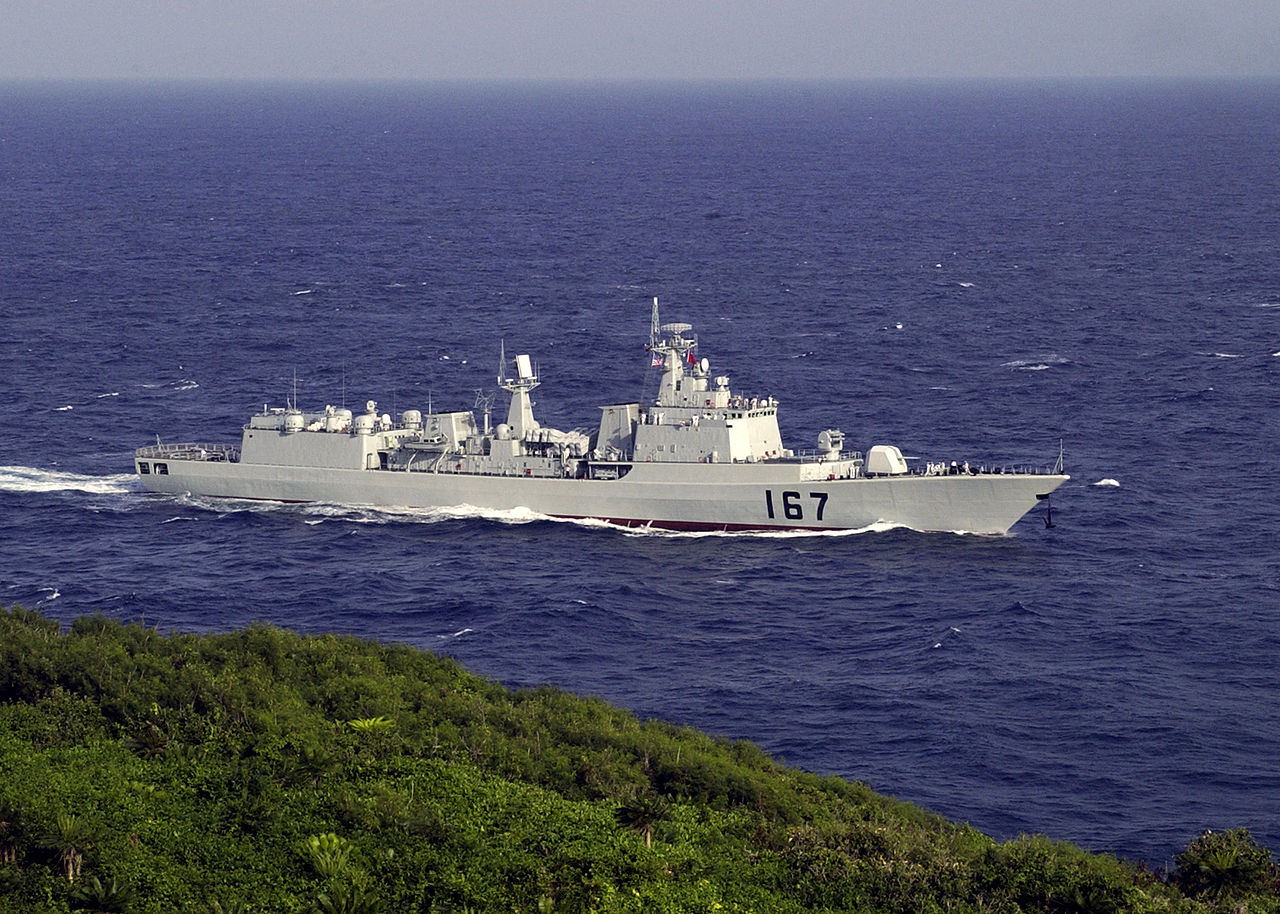
Santa Rita, Guam (Oct. 22, 2003) — The People’s
Liberation Army Navy (PLAN) guided missile destroyer Shenzhen (DDG-167) enters
Apra Harbor, Guam. The Shenzhen and the oiler Quinghai Hu (AO-885) are making
the People’s Republic of China’s first ever port call to Guam.
TYPE 051B LUHAI-CLASS: Consists of only one ship,
No.167 Shenzhen
Shenzhen was laid down by Dalian Shipyard in Northeastern
China in May 1996. The Shenzhen made the switch from the Luhu-Class’
Diesel-Gas-Turbines to Gas Turbine engines. The Luhai-Class is 2,000 tons
larger than the Type 052 destroyer, Luhu-Class.
The Type 051B programme caught great attention at the time
as it was then the largest surface combatant ever built by China. It was also
the first Chinese warship to have adopted the sloped-side hull to reduce the
ship’s radar cross-section profile. However, when the ship was finally
commissioned in late 1998, it became clear that the ship only had very limited
improvement in its weapon systems over the previous Chinese indigenous
destroyers. For example, despite the earlier speculation that the ship would be
equipped with a vertical launch system (VLS) for air defence missile, it turned
out to be only equipped with an eight-cell HQ-7 short-range SAM.
Shenzhen completed its sea trial in late 1998 and joined
service with the PLA Navy South Sea Fleet shortly after. No subsequent ship was
commissioned, though unconfirmed report suggested that a second hull was almost
completed before the construction programme was stopped. The unfinished second
hull was stationed in Dalian Shipyard for several years before it was finally
launched in 2004 to be built as Type 051C (Luzhou class) air defence missile
destroyer 115 Shenyang.
Type 051B was the first Chinese indigenous warship to have
been incorporated with radar cross-section reduction features, including a
streamlined hull with slightly sloped sides and superstructure, two solid masts
with fewer protruding electronic sensor arrays, ‘cleaner’ deck with less weapon
systems piled together, and two funnels with infrared signatures reduction
devices. These features are inherited by the following-on indigenous destroyers
in the PLA Navy.
The ZBJ-1 is the PLAN’s fleet command system. It is
installed aboard major combatants so they can act as command ships. The first
class to receive ZBJ-1 was the Type 051B destroyer but the system proved
unwieldy and was dropped until an improved version was fitted aboard Type 052C
destroyers and the current Type 052D. The ZBJ-1A supports amphibious task
forces and is reputedly installed aboard Type 071 landing platform docks, while
the ZBJ-2 is supposed to be used on the aircraft carrier Liaoning.
The sole Type 051B destroyer 167 Shenzhen participated in
the PLA Navy’s first goodwill visit to Africa in 2000, the first visit to
Europe in 2001 and the first visit to Japan in 2007. In 2004, the ship received
its mid-life modernization refit in 2004, with its original 100mm main gun and
the HQ-7 air defense missile system being replaced by improved models.
In early 2015, the sole Type 051B destroyer was spotted at the Zhanjiang naval base undergoing work. Initially it was unclear whether this was due to a midlife refit program or decommissioning, but pictures revealed in January 2016 that the ship was being refitted with new systems. For self-defense, the four old Type 76A 37 mm AA guns were replaced with two H/PJ-11 eleven-barreled 30 mm CIWS (export designation Type 1130) that can shoot 10,000 rpm, one covering each side. Anti-aircraft defense is upgraded from the 8-unit HQ-7 with a 10–15 km (6.2–9.3 mi) range to a 32-cell vertical launch system (VLS) in front of the superstructure for 50–60 km (31–37 mi)-ranged HQ-16s, directed by four Type 345 (Front-Dome type) illuminators, increasing SAM coverage by 16 times. The helicopter hangar was modified to carry a single Ka-28 ASW helicopter in place of the original dual Z-9 hanger, and two new mast structures were fitted; a Type 382 Radar on the forward mast and a Type 364 targeting radar (under dome) on the aft mast. The upgrades give the Type 051B weapon and sensor capabilities similar to the Type 054A frigate. The Type 382 replaced the Type 381 singe-faced phased-array radar, and moved from the aft to the forward mast to remove the blind arc it previously exhibited, the quarterdeck was fully enclosed, and new apertures were added in the transom indicating that torpedo decoy and towed array sonar systems have been added; a variable depth sonar has not been installed. The ship completed the weapon systems upgrade in August 2016.
Type 051B (Luhai Class) Missile Destroyer
General characteristics
Displacement: 6,100 tons
Length: 153 m
Beam: 16.5 m
Draught: 6 m
Propulsion:
2 Steam turbines
94,000 shp (70,100
kW)
Speed: 31 knots (57
km/h; 36 mph)
Range: 14,000 miles
Complement: 250 (40
officers)
Sensors and processing systems:
Combat data system
– ZKJ-6 Information processing system designed by the 709th Institute (Reported
speed: 10 Mbit/s)
Data link: HN-900
(Chinese equivalent of Link 11 A/B, to be upgraded)
Communication:
SNTI-240 SATCOM
Sea Eagle 3-D air
search radar
Type 360S
air/surface search radar
Type 344
fire-control radar (for 100 mm gun & SSMs)
Hull mounted sonar
Towed array sonar
Armament:
16 YJ-83 anti-ship
missiles
32 HQ-16 VLS
1 dual Type 79A
100mm naval gun
2 Type 1130 CIWS
6 torpedo tubes
2 anti-submarine
rocket systems
Before 2015-16
refit:
16 HQ-7
surface-to-air missiles (replaced by 32 VLS HQ-16)
4 x 37mm AA guns
(replaced by 2 x Type 1130 CIWS)
Aircraft carried: 2 helicopters:
(Kamov Ka-28 or Harbin Z-9C)
Aviation facilities:
Hangar
accommodating 2 helicopters
Landing platform
for one helicopter
Helicopter landing
system